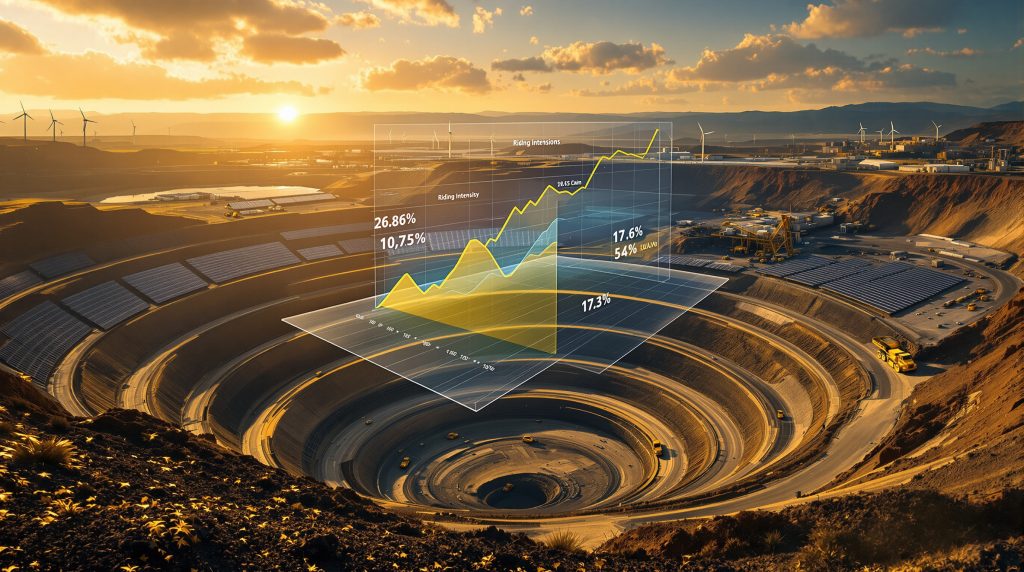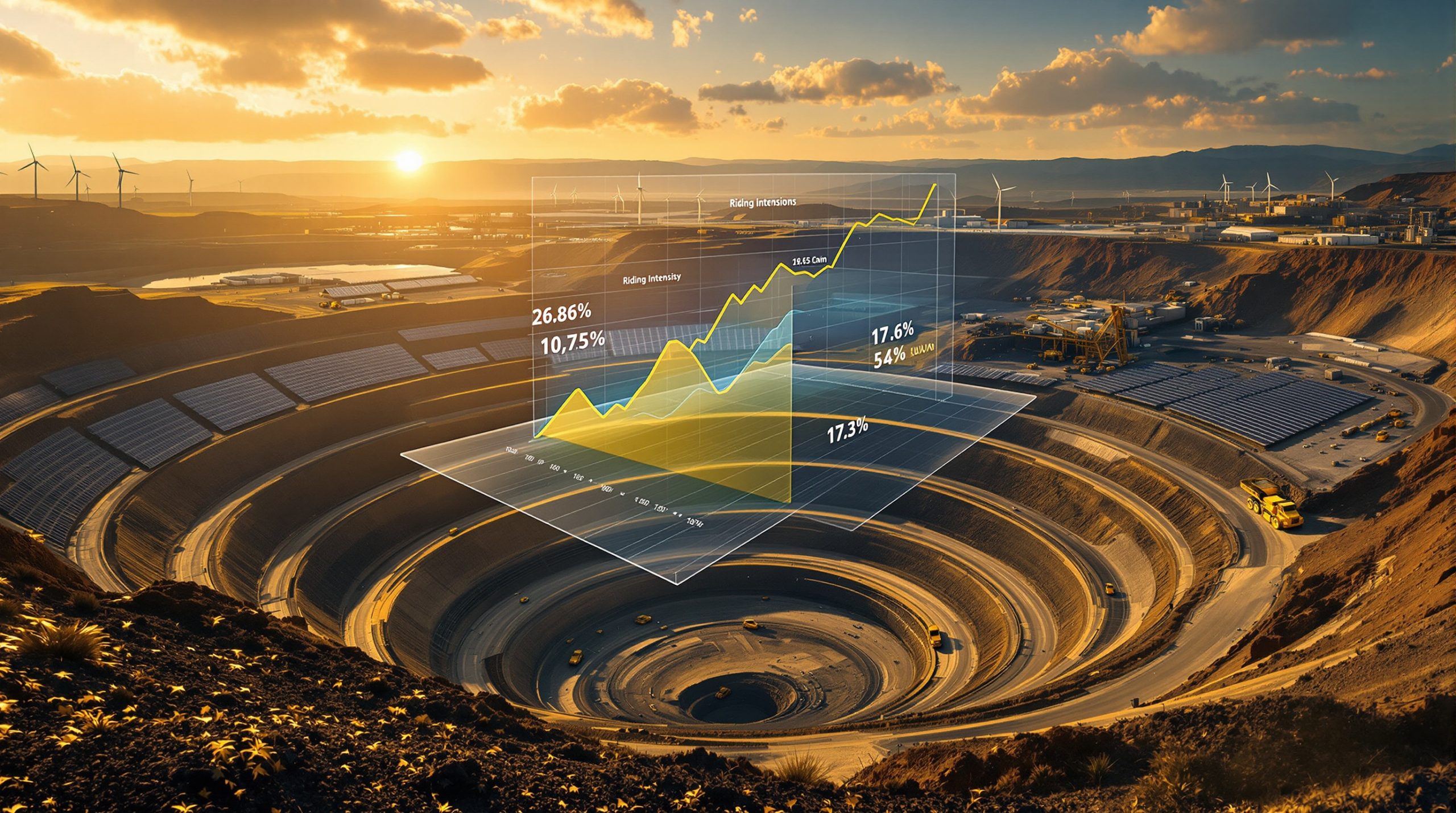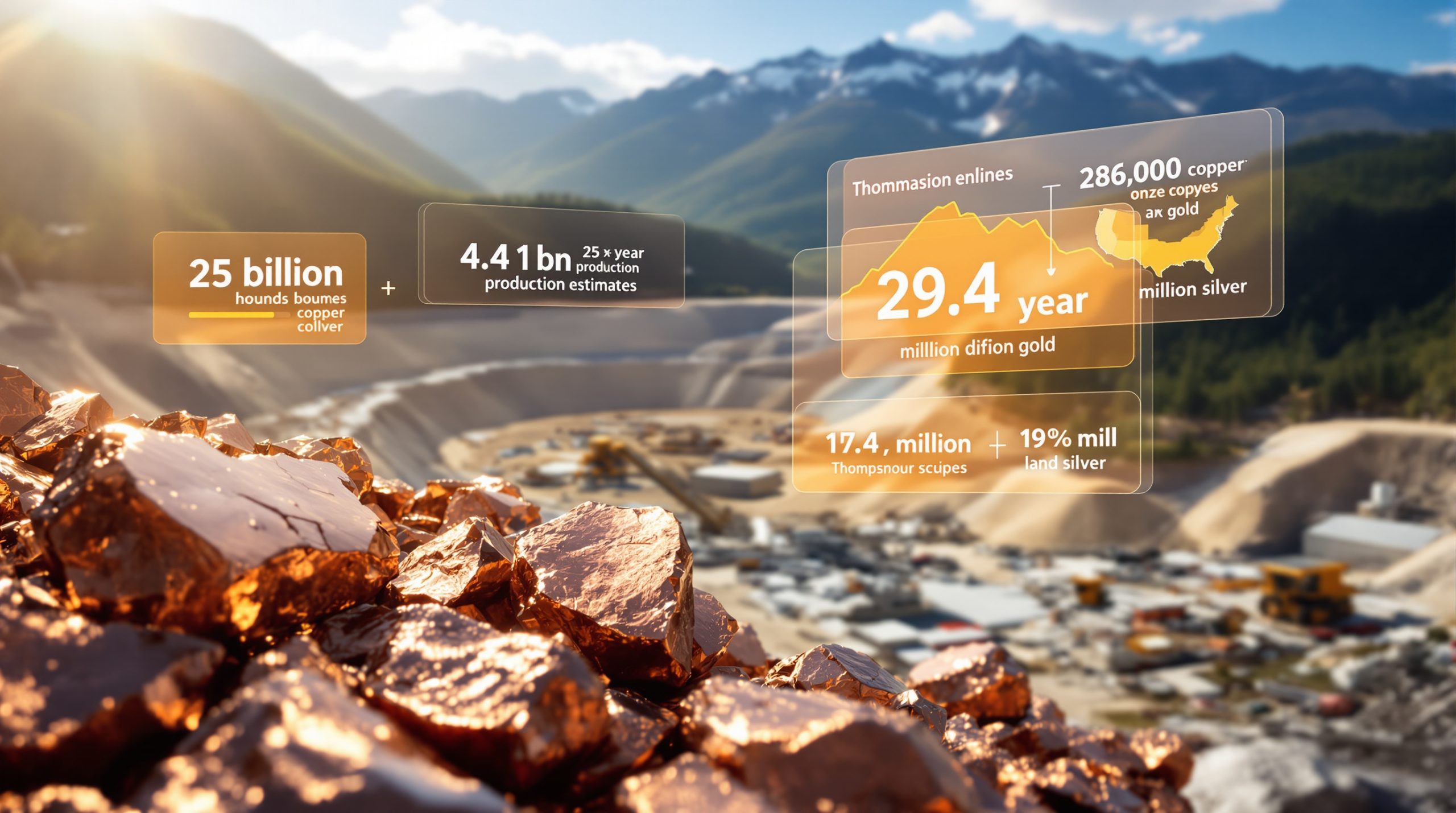How Do Gold Mining Operations Impact Global Emissions?
Gold mining contributes significantly to global greenhouse gas emissions through energy-intensive processes that span extraction, transportation, and refinement. The industry's carbon footprint has come under increasing scrutiny as environmental concerns grow and sustainability transformation standards evolve across the mining sector.
According to a recent Metals Focus report, the world's largest gold producers achieved a significant milestone in 2024, with combined Scope 1 and Scope 2 greenhouse gas emissions falling below 30 million tonnes for the first time since 2014. This development marks an important step in the industry's ongoing sustainability journey.
The Scale of Gold Mining's Carbon Footprint
The gold mining industry generates substantial greenhouse gas emissions across its value chain. While the exact figures vary by mining method and location, most operations emit between 0.8 to 0.9 tonnes of CO2 equivalent for each ounce of gold produced. This intensity multiplies significantly when considering global production volumes.
Industry research indicates the global gold mining sector contributes approximately 45-50 million tonnes of CO2 equivalent annually through direct operations. When including indirect emissions from the entire value chain—from exploration through consumer use—some studies suggest the total footprint could reach 120-130 million tonnes annually.
Primary Emission Sources in Gold Production
The majority of emissions in gold mining originate from two main categories:
Energy consumption (approximately 95% of total emissions):
- Electricity usage for crushing, grinding, and processing equipment
- Diesel fuel for heavy machinery, trucks, and on-site vehicles
- Natural gas for heating solutions during extraction and refining
- Coal-powered electricity in regions with carbon-intensive grids
Process-related emissions (approximately 5% of total emissions):
- Chemical processes during ore treatment
- Methane releases from underground operations
- Land use changes when establishing new mining sites
- Waste management activities throughout the mining lifecycle
What Progress Has Been Made in Reducing Gold Mining Emissions?
The gold mining industry has made notable progress in reducing its environmental impact in recent years. According to the latest Metals Focus report published in Mining Weekly, combined Scope 1 and Scope 2 emissions from major gold producers declined significantly, dropping below 30 million tonnes in 2024—a first since 2014.
This achievement reflects growing industry commitment to sustainability, though challenges remain in maintaining this momentum while meeting global gold demand.
Key Factors Driving Emission Reductions
Several strategic approaches have contributed to the industry's emission reductions:
-
Strategic asset divestments: Major mining companies have strategically sold or closed carbon-intensive operations that were disproportionately contributing to their emissions profile.
-
Renewable energy implementation: The sector has significantly increased its adoption of renewable energy sources, particularly solar and wind power at mine sites where geography permits.
-
Grid connection improvements: Companies have prioritized operations in regions with lower-carbon electricity grids, while also working with utilities to improve grid connections.
-
Energy efficiency initiatives: Technological improvements in processing equipment and operations have reduced energy requirements per unit of production.
Table: Emission Reduction Strategies in Gold Mining
| Strategy | Implementation Examples | Potential Emission Reduction |
|---|---|---|
| Renewable Energy | On-site solar farms, power purchase agreements, wind installations | 15-40% of Scope 2 emissions |
| Electrification | Battery-electric underground vehicles, conveyor systems | 20-50% of Scope 1 emissions |
| Energy Efficiency | High-efficiency grinding, variable speed motors, heat recovery | 5-15% of total energy consumption |
| Grid Decarbonization | Operations in hydropower-rich regions, utility partnerships | Varies by region (10-90%) |
| Process Optimization | AI-controlled processing, ore sorting technology | 5-20% of process emissions |
Why Is Emissions Intensity Increasing Despite Lower Total Emissions?
Despite the reduction in absolute emissions, a concerning trend has emerged: the average emissions intensity across the gold mining industry has increased for the third consecutive year. This paradoxical situation, highlighted in the Metals Focus report, reveals the complex challenges facing the industry.
Emissions intensity—measured as CO2 equivalent emissions per ounce of gold produced—provides a more nuanced view of environmental performance than absolute emissions alone. The rising intensity suggests that while total emissions are decreasing, the efficiency of gold production from an environmental perspective is declining.
Factors Contributing to Rising Emissions Intensity
Several interconnected factors explain this counterintuitive trend:
-
Declining ore grades: As higher-grade deposits become depleted worldwide, companies must process larger volumes of lower-grade ore to produce the same amount of gold, requiring more energy per ounce.
-
Deeper mining operations: Many established mines are extending to greater depths, necessitating additional energy for ventilation, cooling, water management, and material transport.
-
More complex mineralogy: Remaining gold reserves often contain more complex mineral compositions that require additional processing steps and energy inputs.
-
Production volume decreases: When production volumes decline while fixed infrastructure remains operational, emissions are spread across fewer ounces, increasing the per-ounce intensity.
The Metals Focus report specifically notes that lower gold output was a significant factor in the increased emissions intensity, despite the overall reduction in absolute emissions from the world's largest gold producers.
How Do Different Mining Regions Compare in Emissions Performance?
Geographical location significantly influences a gold mine's emissions profile, with regional variations in energy sources creating dramatic differences in environmental performance.
Regional Emission Intensity Variations
The carbon intensity of gold production varies substantially across mining regions:
Low-emission regions typically benefit from hydroelectric or renewable-dominated electricity grids:
- Operations in Quebec (Canada) often emit less than 0.3 tonnes CO2e per ounce due to hydroelectric power
- Mines in Brazil, Norway, and New Zealand similarly benefit from low-carbon electricity
- These operations can achieve up to 70% lower emissions than the global average
Medium-emission regions typically have mixed-source energy grids:
- Australian operations average 0.6-0.8 tonnes CO2e per ounce with their mixed coal and renewable grid
- Western United States operations benefit from increasing renewable penetration
- Mexican mines typically fall in this middle category with mixed energy sources
High-emission regions rely heavily on coal-powered electricity:
- South African operations can exceed 1 tonne CO2e per ounce due to coal-dominated electricity
- Mines in parts of China may reach 1.2 tonnes CO2e per ounce or higher
- Eastern European operations often fall into this higher-emission category
This regional variation underscores how external factors beyond operational efficiency can significantly impact a mine's carbon footprint. Companies with geographically diverse portfolios can strategically shift production to leverage regional advantages in emission intensity.
What Environmental Impacts Beyond Carbon Emissions Does Gold Mining Create?
While carbon emissions represent a significant environmental concern for gold mining, the industry's environmental footprint extends considerably beyond its climate impact. A comprehensive view of gold mining's sustainability challenges must address multiple environmental dimensions.
Mercury Pollution: A Critical Challenge
Mercury pollution represents one of the most severe environmental and health impacts associated with gold mining, particularly in artisanal and small-scale operations (ASGM). These operations account for approximately 20% of global gold production but are responsible for releasing an estimated 1,000 tonnes of mercury annually—making them the largest anthropogenic source of mercury pollution worldwide.
The process typically involves:
- Mixing mercury with crushed ore to create a gold-mercury amalgam
- Heating the amalgam to vaporize the mercury, leaving behind the gold
- Releasing mercury vapor into the atmosphere and residues into waterways
This practice leads to:
- Long-range atmospheric transport of mercury vapor
- Contamination of soil, rivers, and groundwater systems
- Bioaccumulation in the food chain, particularly in fish
- Severe neurological health impacts on miners and surrounding communities
- Persistent environmental damage that continues for decades
Additional Environmental Impacts
Beyond mercury and gold mining emissions, operations create several other significant environmental challenges:
- Chemical contamination: Industrial gold mining typically uses cyanide for gold extraction, which presents risks to water systems and wildlife when not properly managed
- Water resource impacts: Gold mining is water-intensive, with a single large-scale mine potentially using millions of gallons daily while also risking contamination of groundwater
- Land disturbance: Open-pit mining can transform landscapes, resulting in deforestation, habitat destruction, and soil erosion
- Waste generation: For every ounce of gold produced, mines generate approximately 79 tonnes of waste material, including potentially acid-generating tailings
- Air quality issues: Dust generation, diesel emissions, and processing chemicals contribute to localized air quality degradation
How Are Leading Gold Mining Companies Addressing Sustainability Challenges?
Major gold producers have implemented various strategies to address environmental impacts while maintaining operational viability. Their approaches combine technological innovation, operational improvements, and strategic energy transitions.
Case Study: South Deep Solar Project
Gold Fields' South Deep mine in South Africa exemplifies the industry's shift toward renewable energy integration. Located in a region heavily dependent on coal-fired electricity, the mine implemented a strategic solution to reduce its carbon footprint:
The 50 MW solar plant, commissioned in 2022:
- Generates approximately 103 GWh of electricity annually
- Provides up to 24% of the mine's electricity needs during peak solar hours
- Reduces the operation's annual carbon emissions by approximately 110,000 tonnes
- Required a $83 million investment with a projected 9-year payback period
- Serves as a model for similar projects across the industry
The South Deep project demonstrates how mines in high-emission regions can substantially reduce their footprint through strategic renewable energy investments, while also gaining partial independence from unreliable grid power.
Industry-Wide Sustainability Initiatives
Leading gold mining companies are implementing comprehensive sustainability programs that include:
-
Science-based emission reduction targets: Major producers have committed to specific, measurable targets aligned with the Paris Agreement, typically aiming for 30-50% reductions by 2030 and net-zero operations by 2050
-
Energy transition roadmaps: Companies have developed detailed implementation plans for transitioning energy sources, including renewable integration timelines and electrification milestones
-
Water stewardship programs: Enhanced water recycling systems, reduced freshwater withdrawal, and watershed protection initiatives are becoming standard practice
-
Biodiversity conservation: Progressive rehabilitation, habitat offset programs, and minimized footprint designs help preserve biodiversity in mining regions
-
Community engagement: Partnerships with local communities ensure sustainability initiatives address local priorities while providing long-term benefits beyond the mine's operational life
What Technologies Are Transforming Emission Reduction in Gold Mining?
Technological innovation plays a crucial role in addressing the emissions challenges facing the gold mining industry, with several emerging solutions showing particular promise.
Emerging Technologies for Emission Reduction
-
Hydrogen-powered heavy equipment: Several major mining companies are partnering with equipment manufacturers to develop and test hydrogen fuel cell technology for haul trucks and other heavy machinery, with potential to eliminate diesel emissions from these significant sources
-
AI in mining operations: AI-controlled systems optimize crushing, grinding, and processing operations in real-time, reducing energy usage by 5-15% while improving recovery rates and reducing processing time
-
Advanced ore sorting: Pre-concentration technologies using X-ray, optical, or sensor-based sorting can identify and remove waste rock before energy-intensive processing, potentially reducing energy consumption by 10-30% in applicable operations
-
Dry stack tailings: This alternative tailings management approach eliminates the need for conventional tailings dams, reducing water usage by up to 90% and decreasing associated emissions from pumping and processing
-
Microgrids and energy storage: Sophisticated energy management systems combine renewable generation with battery storage to maximize renewable utilization and provide stable power supply, enabling higher renewable penetration than otherwise possible
Barriers to Technology Adoption
Despite their potential benefits, several factors limit the widespread adoption of these technologies:
-
High capital investment requirements: Many emission-reduction technologies require substantial upfront investment, creating financial barriers for smaller operators and mines with shorter remaining lifespans
-
Technical challenges in implementation: Site-specific factors like deposit characteristics, geographical location, and existing infrastructure can complicate technology implementation
-
Operational risks during transition: Introducing new technologies can temporarily disrupt production, creating operational and financial risks during transition periods
-
Regulatory uncertainties: Varying environmental regulations across jurisdictions create uncertainty regarding compliance requirements and financial incentives for technology adoption
-
Skills and knowledge gaps: Many emerging technologies require specialized expertise not traditionally found in mining operations, necessitating workforce development
What Does the Future Hold for Gold Mining Emissions?
The gold mining industry stands at a critical juncture regarding its environmental impact and sustainability trajectory. External pressures and industry innovation trends are reshaping how companies approach emissions reduction.
Future Emission Trends and Projections
Industry analysts project several key trends for the coming decade:
-
Accelerated renewable energy adoption: Declining costs of solar, wind, and storage technologies will make renewable integration economically advantageous for more operations, potentially doubling renewable penetration in the mining sector by 2030
-
Electrification of mining fleets: Battery technology improvements are enabling the gradual replacement of diesel equipment with electric alternatives, with underground operations leading this transition due to their ventilation benefits
-
Carbon pricing impacts: Growing implementation of carbon taxes and cap-and-trade systems will increasingly influence operational decisions, potentially adding $15-40 per ounce to production costs in high-emission operations
-
Investor pressure: ESG-focused investors now control approximately 40% of mining sector investments and are demanding clearer emission reduction roadmaps and performance metrics
-
Regulatory evolution: Major mining jurisdictions are implementing stricter emission regulations, with some regions mandating 5-15% reductions every five years
The Balance Between Production and Sustainability
The industry faces ongoing challenges in balancing production demands with environmental responsibilities. This tension will shape strategic decisions regarding:
- Mine development and expansion: Projects with high projected emissions intensity face increasing scrutiny and financing challenges
- Processing technology selection: Higher-efficiency technologies may receive preference despite higher initial costs
- Energy infrastructure investments: Long-term renewable energy contracts become more attractive despite their commitment requirements
- Community and stakeholder engagement: Local environmental impacts receive greater attention in project planning and operations
- Corporate sustainability commitments: Companies increasingly view sustainability performance as central to their license to operate rather than a peripheral concern
How Can Consumers and Investors Influence Gold Mining Emissions?
Both consumers and investors exercise growing influence over environmental practices in the gold mining sector through their choices and preferences.
Consumer Impact Through Purchasing Decisions
Consumers can shape mining practices through:
- Preference for certified sustainable gold: Certification programs like the Responsible Gold Mining Principles and Fairtrade Gold verify mining operations that meet specific environmental and social standards
- Recycled gold options: Choosing jewelry and products made from recycled gold reduces demand for newly mined material, with recycled gold requiring approximately 90% less energy than primary mining
- Transparency demands: Consumer pressure for supply chain transparency has prompted many jewelry retailers to disclose sourcing information and sustainability metrics
These consumer choices send economic signals throughout the supply chain, potentially shifting production toward lower-emission sources. Market research indicates consumers are increasingly willing to pay 5-15% premiums for responsibly sourced gold products.
Investor Influence Through Capital Allocation
Investors have become powerful drivers of environmental improvement in gold mining through:
- ESG screening criteria: Many institutional investors now apply environmental filters that exclude high-emission mining companies from their portfolios
- Shareholder resolutions: Investor-led resolutions demanding emission reduction targets and climate risk disclosure have received majority support at several major mining companies
- Engagement with management: Direct dialogue between investors and company leadership has accelerated adoption of science-based emission targets
- Capital allocation decisions: Companies with stronger environmental performance typically enjoy 10-30% lower capital costs, creating significant financial incentives
Investment decisions directly impact companies' access to capital and cost of financing, effectively pricing climate risk into business operations. This financial pressure often accelerates emission reduction efforts more effectively than regulatory requirements alone.
FAQ: Gold Mining Emissions
What are Scope 1 and Scope 2 emissions in gold mining?
Scope 1 emissions refer to direct greenhouse gas emissions from sources owned or controlled by the mining company. In gold mining operations, these typically include diesel used in vehicles and equipment, natural gas for heating, and process emissions from chemical reactions during extraction and refining.
Scope 2 emissions are indirect emissions from purchased electricity, steam, heating, and cooling consumed by the company. For many gold miners, especially those running energy-intensive processing operations, Scope 2 emissions constitute 60-80% of their operational carbon footprint. The carbon intensity of the local electricity grid significantly influences these emissions.
How does gold mining compare to other metal mining in terms of emissions?
Gold mining typically has higher emissions per unit of metal produced compared to base metals like copper or iron. This emission intensity difference stems primarily from ore grade disparities—while copper mines might process ore containing 0.5-1% metal content, gold mines typically work with ore containing just 1-4 grams of gold per tonne (0.0001-0.0004%).
This means gold mining requires processing approximately 250-1,000 times more ore per unit of metal produced compared to copper mining, resulting in substantially higher energy requirements and emissions. When measured per dollar value of production, however, gold's emissions intensity appears more favorable due to gold's high economic value per ounce.
What role does ore grade play in gold mining emissions?
Ore grade is perhaps the most critical factor determining emissions intensity in gold mining operations. As ore grades decline:
- More material must be mined, crushed, and processed to produce each ounce of gold
- Energy requirements increase proportionally with the volume of material processed
- Water usage, chemical consumption, and waste generation all expand accordingly
The industry has experienced a steady decline in average ore grades over decades, with many new projects operating at grades 40-60% lower than historical averages. This trend presents a fundamental challenge to emission reduction efforts, as efficiency improvements must first offset the inherent emission increases from declining grades before achieving net reductions.
Understanding these complex relationships between ore quality, production techniques, and environmental impacts provides essential context for evaluating the gold mining industry's sustainability challenges and progress. Furthermore, as the industry continues to evolve, mine reclamation innovation and mining decarbonisation benefits will become increasingly important in addressing the environmental legacy of gold mining operations.
Ready to Find Tomorrow's Mineral Discovery Today?
Gain instant notifications on significant ASX mineral discoveries with Discovery Alert's proprietary Discovery IQ model, which transforms complex mineral data into actionable insights for investors. Understand why historic discoveries can generate substantial returns by visiting the Discovery Alert's dedicated discoveries page and begin your 30-day free trial today to position yourself ahead of the market.




